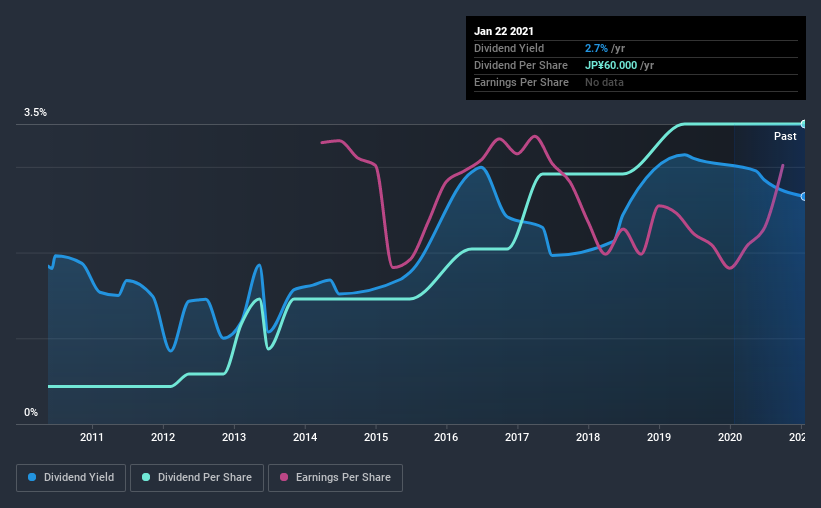
Is Watanabe Sato Co., Ltd. (TYO:1807) a good dividend stock? How can we tell? Dividend paying companies with growing earnings can be highly rewarding in the long term. If you are hoping to live on your dividends, it's important to be more stringent with your investments than the average punter. Regular readers know we like to apply the same approach to each dividend stock, and we hope you'll find our analysis useful.
A 2.7% yield is nothing to get excited about, but investors probably think the long payment history suggests Watanabe Sato has some staying power. The company also returned around 2.1% of its market capitalisation to shareholders in the form of stock buybacks over the past year. Some simple research can reduce the risk of buying Watanabe Sato for its dividend - read on to learn more.
Explore this interactive chart for our latest analysis on Watanabe Sato!

Payout ratios
Dividends are typically paid from company earnings. If a company pays more in dividends than it earned, then the dividend might become unsustainable - hardly an ideal situation. So we need to form a view on if a company's dividend is sustainable, relative to its net profit after tax. Watanabe Sato paid out 13% of its profit as dividends, over the trailing twelve month period. We like this low payout ratio, because it implies the dividend is well covered and leaves ample opportunity for reinvestment.
In addition to comparing dividends against profits, we should inspect whether the company generated enough cash to pay its dividend. Watanabe Sato paid out 6.3% of its free cash flow as dividends last year, which is conservative and suggests the dividend is sustainable. It's encouraging to see that the dividend is covered by both profit and cash flow. This generally suggests the dividend is sustainable, as long as earnings don't drop precipitously.
With a strong net cash balance, Watanabe Sato investors may not have much to worry about in the near term from a dividend perspective.
Consider getting our latest analysis on Watanabe Sato's financial position here.
Dividend Volatility
Before buying a stock for its income, we want to see if the dividends have been stable in the past, and if the company has a track record of maintaining its dividend. Watanabe Sato has been paying dividends for a long time, but for the purpose of this analysis, we only examine the past 10 years of payments. The dividend has been stable over the past 10 years, which is great. We think this could suggest some resilience to the business and its dividends. During the past 10-year period, the first annual payment was JP¥7.5 in 2011, compared to JP¥60.0 last year. This works out to be a compound annual growth rate (CAGR) of approximately 23% a year over that time.
It's rare to find a company that has grown its dividends rapidly over 10 years and not had any notable cuts, but Watanabe Sato has done it, which we really like.
Dividend Growth Potential
While dividend payments have been relatively reliable, it would also be nice if earnings per share (EPS) were growing, as this is essential to maintaining the dividend's purchasing power over the long term. Earnings have grown at around 5.0% a year for the past five years, which is better than seeing them shrink! With a decent amount of growth and a low payout ratio, we think this bodes well for Watanabe Sato's prospects of growing its dividend payments in the future.
Conclusion
To summarise, shareholders should always check that Watanabe Sato's dividends are affordable, that its dividend payments are relatively stable, and that it has decent prospects for growing its earnings and dividend. It's great to see that Watanabe Sato is paying out a low percentage of its earnings and cash flow. Second, earnings growth has been mediocre, but at least the dividends have been relatively stable. Watanabe Sato performs highly under this analysis, although it falls slightly short of our exacting standards. At the right valuation, it could be a solid dividend prospect.
Companies possessing a stable dividend policy will likely enjoy greater investor interest than those suffering from a more inconsistent approach. At the same time, there are other factors our readers should be conscious of before pouring capital into a stock. For example, we've identified 2 warning signs for Watanabe Sato (1 shouldn't be ignored!) that you should be aware of before investing.
Looking for more high-yielding dividend ideas? Try our curated list of dividend stocks with a yield above 3%.
When trading Watanabe Sato or any other investment, use the platform considered by many to be the Professional's Gateway to the Worlds Market, Interactive Brokers. You get the lowest-cost* trading on stocks, options, futures, forex, bonds and funds worldwide from a single integrated account. Promoted
Valuation is complex, but we're here to simplify it.
Discover if Watanabe Sato might be undervalued or overvalued with our detailed analysis, featuring fair value estimates, potential risks, dividends, insider trades, and its financial condition.
Access Free AnalysisThis article by Simply Wall St is general in nature. It does not constitute a recommendation to buy or sell any stock, and does not take account of your objectives, or your financial situation. We aim to bring you long-term focused analysis driven by fundamental data. Note that our analysis may not factor in the latest price-sensitive company announcements or qualitative material. Simply Wall St has no position in any stocks mentioned.
*Interactive Brokers Rated Lowest Cost Broker by StockBrokers.com Annual Online Review 2020
Have feedback on this article? Concerned about the content? Get in touch with us directly. Alternatively, email editorial-team (at) simplywallst.com.
About TSE:1807
Watanabe Sato
Engages in the contracting and investigation, research, planning, designing, supervision, technical guidance, and consultation of civil engineering construction activities.
Established dividend payer with adequate balance sheet.
Market Insights
Community Narratives




